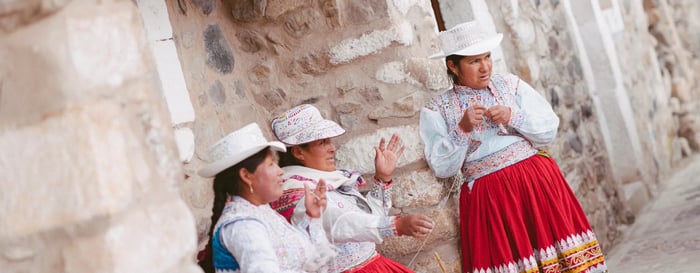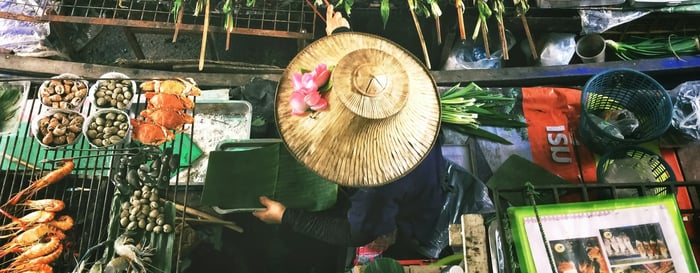“Cheeky monkeys... They don’t usually come near the kitchen, but they want to play today,” tuts the petit Malaysian chef as a monkey strutted along the edge of the carved wooden balcony and bounced on to the roof.
It was clear that today wasn’t your average cooking lesson. This morning I had left the Four Seasons Hotel at KLCC, Kuala Lumpur and been driven high into the hillsides that surround the capital. After leaving the hubbub of the city behind we wound our way up the quiet hillside to spy a 100-year-old traditional Malay house tucked away in the jungle.
The former owner had transported the house timber by timber from Penang to this nature reserve, and it is now the Lazat Cooking School where hungry visitors come to learn how to cook Malaysian food.

We took our seats in the traditional open kitchen that looked out over the valley. Over the next five hours we would learn how to make cucur jagung (corn fritters), dhal curry, roti canai and watch the chefs make sulji halwa and mee goreng. Lazat means delicious in Malay and the menu quite clearly lived up to the name of the cooking school.
We had two teachers for the day, Rashid, who had been making rotis for more than 40 years in Kuala Lumpur and Tasha, who started cooking with her aunty at the age of eight, and then after leaving culinary school went on to work at Osteria Mozza run by Chef Mario Batali at Marina Bay Sands in Singapore.
Our first lesson was with Rashid, who taught us the art of the roti. After demonstrating how to make the roti batter, he set us the task of the rolling and swinging our own roti canai into neat parcels. After pushing the dough into a round the size of a small plate, he then deftly swung the sheet of dough over the back of his left hand in a swift 360 motion. After each smooth circular motion, the rich roti dough would become twice the size. He then let the roti rest as in a loose roll, before pushing out the doughy treat once more and launching it on to the hot plate.
Rashid encouraged us to pick up a ball of dough, dab it with a splash of oil, then press it out into a small, soft disc with the palms of our hands, before spinning it into a thin sheet with the panache of an Italian pizza maker. But before letting us loose on the dough, Rashid had us hone our technique with the help of a side plate and a hand towel. Within seconds we felt as if we could take over our own roti stand, as the hand towel swung around our hands with ease and flattened out on the table in front of us. But then he gave us the dough and the process didn’t go as smoothly. The hand towel, didn’t collapse on itself and stick to the back of my hand like the dough did. The hand towel also didn’t tear when I threw it skywards.
However, Rashid calmly rescued each calamity and was full of words of encouragement when anything close to a roti was slapped down on the stainless steel table in front of him. When Rashid’s rotis left the hot plate, they were flaky and fluffy and golden in colour – whereas my rotis were as solid as the side plate I had just lifted them off.
For the next part of the course, we walked to the other side of the open kitchen to join Tasha. Firing up the Malaysian brass woks and using the bamboo skewers, she showed us how to create cucur jagung (corn fritters). This snack, which Malaysians like to enjoy for breakfast or supper, is served with sweet chilli sauce.

We combined flour, sweet corn, prawns, bean sprouts, shallots, turmeric and water to create a thick dough heaving with vegetables and shellfish, that we then scooped into balls and placed them into the small wok filled with oil. Bubbling away within the golden liquid, these savoury delicacies were far more successful and after I raised them out of the oil, they glistened on a rack as Tasha demonstrated the next course.
Our next dish was dhal curry, which we would be able to eat later with our rotis. Tasha asked us to pick up a stone pestle and bash a piece of garlic and then ginger into submission, then dice potatoes and carrots and leave them to all bubble away together in a pan.
Tasha continued to pass on little tips throughout the process, including how if a woman doesn’t want to remain single, she shouldn’t knock the spoon on the side of the pan as it’s considered uncouth. She should lightly tap the residue off from a spoon by banging it lightly on her fingers into the pan. If I wanted to show that I was annoyed with my husband, I should bang the pestle on the bottom of the mortar when I am preparing the food. When she told me that a pestle was a tool that you used to control your husband I thought she meant you should throw it at him. However, the Malay way is far more subtle. “Malay people want to enjoy the scents of the food and then the taste of the food, with Malay cooking there should never be a commotion in the kitchen,” says Tasha.
Tasha went on to demonstrate how to make mee goring and sulji halwa. She said unlike Chinese cooking where dishes can be made in 20 minutes, the Malay way is a lot slower and almost meditative. And I have to agree, apart from a short period of time where we thought that one of the monkeys might swing into the open kitchen and turning it into a thrash metal concert, the Lazat kitchen was as tranquil as any five-star spa. If we didn’t have Tasha there to keep an eye on us, we could have easily burnt the contents of our pans as we drifted off looking out over lush green jungle that greeted the edge of the balcony.
As we ate our homemade dishes in the cooking school’s treetop dining room, we had learnt a lot more than how to deseed chillies (which you do by slicing off the skin and leaving the core), we had learnt to embrace the slow life.
If you want to experience Malaysia for yourself, contact the Lightfoot Travel Asia team.
A Culinary Journey Through Peru
Lima Cusco, Sacred Valley, & Machu Picchu
- Discover the colonial and modern side of Lima on a private guided tour
- Enjoy a typical Peruvian feast while watching a Paso horse show
- Meet Manuel Choqque, one of the world's most celebrated producers,
- Explore the magnificent Inca site of Machu Picchu
- Learn how to make traditional Peruvian dishes at a cookery class in Cusco
- Dine at some of the world's best restaurants in Cusco
Classic Thailand
Bangkok Chiang Mai, Chiang Rai & the Golden Triangle Phuket & Khao Lak Thailand Asia
- Explore Bangkok’s beautiful temples and vibrant streets
- Learn how to create local Thai dishes in Chiang Mai with a private cookery class
- Laze on some of Phuket's best white sandy beaches
- Sample various local foods, old-style Thai coffee and Thai sweet desserts
- Visit the Thai Elephant Conservation Centre and watch these wonderful animals in their natural habitat
Walking & Wine in Western Australia
Western Australia Australia Australasia
-
Discovering Perth and enjoying Shambhala spa’s treatments
-
Walking the picturesque track from Bunker Bay to Sugarloaf Rock
-
Enjoy a four course tasting menu with paired wines
-
Hike from Redgate Beach to Boranup Drive
-
Take a scenic helicopter tour of the area








